| Srl | Item |
| 1 |
ID:
116231
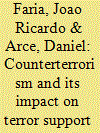

|
|
|
|
|
| Publication |
2012.
|
| Summary/Abstract |
This article presents a dynamic model in which counterterrorism policies have the potential to generate positive public support for terrorism via a backlash that may fuel terror recruitment. For an optimizing government aiming at maximizing security, this phenomenon produces a natural bound on proactive counterterror policy that is related to the dynamic path of conflict. Moreover, terror is a persistent phenomenon that requires patience on the part of the target government for optimal counterterror policies to be realized. Finally, the potential for backlash yields insights into the need for target governments to fight an information war to change public opinion regarding its own policies and the ultimate effect of terror attacks.
|
|
|
|
|
|
|
|
|
|
|
|
|
|
|
|
| 2 |
ID:
116233
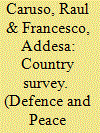

|
|
|
|
|
| Publication |
2012.
|
| Summary/Abstract |
This paper analyses the military expenditures in Italy over the period 1988-2008. The estimation of a conventional model of military expenditure shows that the choices of military expenditure by Italian governments are influenced by US and, to a lesser extent, the other NATO countries' defence spending. In particular, the negative association between the US and NATO average military expenditure on the Italian one suggests a free-rider behaviour of Italy. Eventually, we focus on the relationship between productivity and military expenditure. The results suggest that there is a negative association between productivity and military expenditures in the long run. Namely, if military expenditures were substituted by civilian expenditures, the Italian overall productivity would be expected to improve.
|
|
|
|
|
|
|
|
|
|
|
|
|
|
|
|
| 3 |
ID:
116234


|
|
|
|
|
| Publication |
2012.
|
| Summary/Abstract |
This article empirically explores the relationship between military expenditure, external debts and economic performance in the economies of sub-Saharan Africa using a sample of 25 countries from 1988-2007. In investigating the defence-external debt nexus, we employ three advanced panel techniques of fully modified OLS (FMOLS), Dynamic OLS (DOLS) and dynamic fixed effect (DFE) to estimate our model. We observe that military expenditure has a positive and significant impact on external debt in African countries. Real GDP affects the total debt stock of African countries with a negative relationship. Our empirical results based on long-run elasticities show that a 1% rise in national output leads to a decline in external debt by 1.52%, on average. Policy-wise, the study suggests that African countries need to strengthen areas of fiscal responsibility and pursue models that encourage rational spending, particularly reductions in military expenditure.
|
|
|
|
|
|
|
|
|
|
|
|
|
|
|
|
| 4 |
ID:
116232
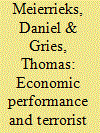

|
|
|
|
|
| Publication |
2012.
|
| Summary/Abstract |
We investigate the link between economic performance and terrorism for 18 Latin American countries from 1970 to 2007, taking into account the potentially complex nature of this link. Panel causality analysis findings indicate that during this period, terrorism had no causal effect on economic growth. By contrast, we find that growth reduced terrorism in the less developed but not in the higher developed Latin American economies. We argue that group-specific differences (linked to patterns of economic development) govern this causal heterogeneity. From a series of negative binomial regressions we gain additional support for our findings, while also identifying further determinants of terrorism.
|
|
|
|
|
|
|
|
|
|
|
|
|
|
|
|
| 5 |
ID:
116230


|
|
|
|
|
| Publication |
2012.
|
| Summary/Abstract |
Governments fighting terrorists have many tactical options, yet these options often yield unintended and counterproductive consequences. This paper models a terrorist organization, a religious group from which the terrorists recruit suicide bombers, and the society in which the terrotists are imbedded. The model illuminates how the choice of counterterrorist tactics influences the incidence of attacks, paying particular attention to the direct and indirect (unintended) consequences of the government's actions. The ultimate goal of this work is to identify the best way to stop terrorist attacks.
|
|
|
|
|
|
|
|
|
|
|
|
|
|
|
|
| 6 |
ID:
116235


|
|
|
|
|
| Publication |
2012.
|
| Summary/Abstract |
The contest-theoretic literature on the attack and defense of networks of targets focuses primarily on pure-strategy Nash equilibria. Hausken's 2008 European Journal of Operational Research article typifies this approach, and many of the models in this literature either build upon this model or utilize similar techniques. We show that Hausken's characterization of Nash equilibrium is invalid for much of the parameter space examined and provides necessary conditions for his solution to hold. The complete characterization of mixed-strategy equilibria remains an open problem, although there exist solutions in the literature for special prominent cases.
|
|
|
|
|
|
|
|
|
|
|
|
|
|
|
|
| 7 |
ID:
116236
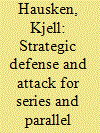

|
|
|
|
|
| Publication |
2012.
|
| Summary/Abstract |
Kovenock and Roberson's (2012a, b) replication of Hausken's (2008a) equations and parameter restrictions do not enhance our insight into the defense and attack of reliability systems. This reply intends to fill the remaining understanding gaps.
|
|
|
|
|
|
|
|
|
|
|
|
|
|
|
|
| 8 |
ID:
116237


|
|
|
|
|
| Publication |
2012.
|
| Summary/Abstract |
In our original comment, we showed that Hausken's characterization of Nash equilibrium is invalid for much of the parameter space examined and provided necessary conditions for his solution to hold. Most of the comments in his reply are either tangential or irrelevant. However, several of the claims made in the reply reveal continuing misunderstandings and gaps in his understanding. In this rejoinder, we briefly clarify the fundamental issues.
|
|
|
|
|
|
|
|
|
|
|
|
|
|
|
|
| 9 |
ID:
116238
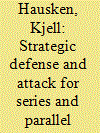

|
|
|
|
|
| Publication |
2012.
|
| Summary/Abstract |
Kovenock and Roberson's [2011] comment provides initial work which has the potential, when suitably extended, to advance the research frontier. Kovenock and Roberson's paper consists of three sections. The first section is an interesting introduction. The second section, titled 'Model and Main Result,' provides no contribution beyond Hausken [2008a]. It consists of Equations (1)-(10) which are equivalent to equations developed by Hausken, and Equation (11) which is equivalent to the utility requirements u??0 and U??0 provided after Equation (17) in Hausken. The third section provides interesting ideas about mixed-strategy equilibria that can be extended in future research.
|
|
|
|
|
|
|
|
|
|
|
|
|
|
|
|